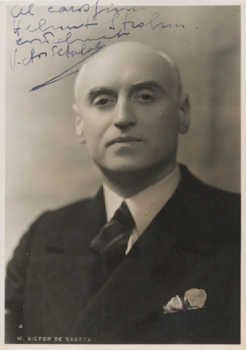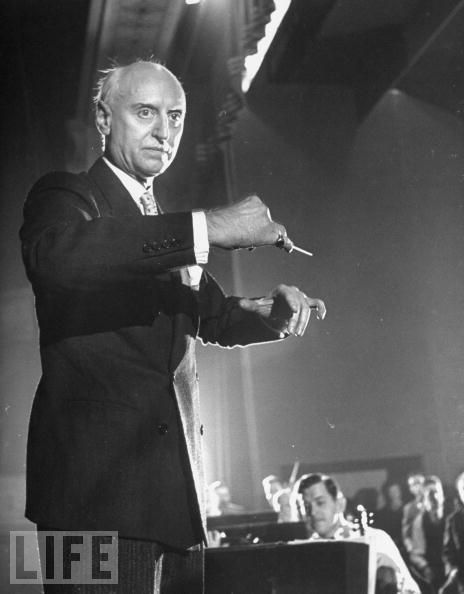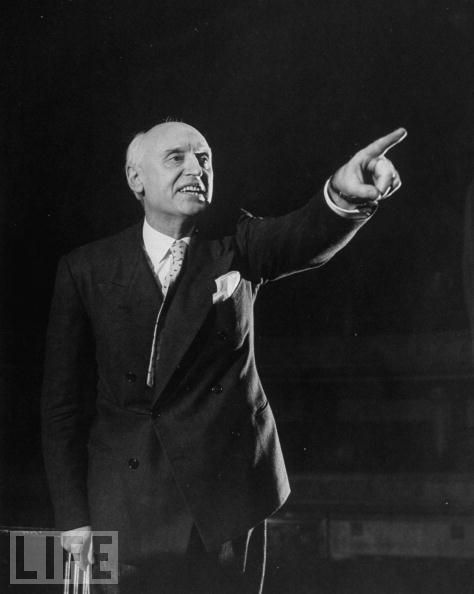<Back to Index>
- Physiologist Bernardo Alberto Houssay, 1887
- Conductor Victor de Sabata, 1892
- Emperor of the Byzantine Empire Theodosius II, 401
PAGE SPONSOR



Victor de Sabata (April 10, 1892 – December 11, 1967) was an Italian conductor and composer. He is widely recognized as one of the most distinguished operatic conductors of the twentieth century, especially for his Verdi, Puccini and Wagner. He is also acclaimed for his interpretations of orchestral music. Like his near contemporary Wilhelm Furtwängler, de Sabata regarded composition as more important than conducting but achieved more lasting recognition for his conducting than his compositions. De Sabata has been praised by various authors and critics as a rival to Toscanini for the title of greatest Italian conductor of the twentieth century, and even as "perhaps the greatest conductor in the world".
De Sabata was born in the city of Trieste, at the time part of Austria - Hungary, but now in Italy. His Roman Catholic father Amedeo de Sabata was a professional singing teacher and chorus master, and his mother, a talented amateur musician, was Jewish. De Sabata began playing the piano at the age of four, and composed a gavotte for that instrument at the age of six. He composed his first work for orchestra at the age of twelve. His formal musical studies began after his family moved to Milan around 1900. In Milan, de Sabata studied at the Giuseppe Verdi Conservatory, excelling at piano, violin, theory, composition and conducting, and graduating cum laude in composition, piano and violin. He would remain a virtuoso pianist and violinist up until the end of his life. In 1911 he performed in an orchestra under the baton of Arturo Toscanini who influenced him to become a conductor. De Sabata's first opera, Il macigno, was produced at the opera house of La Scala on March 31, 1917 to a mixed reception. It was frequently performed during the next few years.
In 1918 de Sabata was appointed conductor of the Monte Carlo Opera, performing a wide variety of late 19th century and contemporary works. In 1925, he conducted the world premiere of L'enfant et les sortilèges by Ravel. Ravel said that de Sabata was a conductor "the like of which I have never before encountered" and wrote him a note the next day saying that "You have given me one of the most complete joys of my career". Ravel also claimed that, within twelve hours of receiving the score to L'enfant, the conductor had memorized it. In 1921, while still conducting opera at Monte Carlo, de Sabata began his career as a symphonic conductor with the Orchestra of the Accademia di Santa Cecilia in Rome. In 1927 he made his U.S. debut with the Cincinnati Symphony Orchestra, substituting for Fritz Reiner in the first eight concerts of the year. He did the same in 1928.
De Sabata conducted the orchestra of La Scala in concert starting in the 1921 – 1922 season, and conducted opera there from 1929. He became the principal conductor in 1930 in succession to Toscanini. Soon after taking up the post, he resigned because of a disagreement with the orchestra over the poor reception of his composition A Thousand and One Nights. Toscanini wrote him a letter in order to persuade him to return, saying that his absence was "damaging to you and the theater". De Sabata did return to La Scala, and continued in the post for over 20 years. However, he did not reply to Toscanini, and the two conductors remained estranged until the 1950s.
During the 1930s, de Sabata conducted widely in Italy and Central Europe. In 1933 he made his first commercial recordings with the Orchestra of the Italian Broadcasting Authority in Turin, including his own composition Juventus. According to Benito Mussolini's son Romano, de Sabata was "a personal friend" of the Italian dictator, and gave "several concerts" at the leader's Villa Torlonia home. De Sabata's friendship with Mussolini became another factor distancing him from his former mentor Toscanini.
In 1936, he appeared with the Vienna State Opera. In 1939, he became only the second conductor from outside the German speaking world to conduct at Bayreuth when he led Wagner's opera Tristan und Isolde (Toscanini had been the first, in 1930 and 1931). Among the audience at Bayreuth was the young Sergiu Celibidache who hid in the lavatory overnight in order to surreptitiously attend rehearsals. That same year he made celebrated recordings of Brahms, Wagner and Richard Strauss with the Berlin Philharmonic Orchestra. He also forged a friendship with the young Herbert von Karajan. It is unclear why de Sabata was allowed to work in Germany by the Nazi regime despite his part-Jewish background. In the closing stages of the war, de Sabata helped Karajan relocate his family to Italy.
After World War II, de Sabata's career expanded internationally. He was a frequent guest conductor in London, New York and other American cities. In 1946 he recorded with the London Philharmonic Orchestra for the Decca recording company. In 1947 he switched labels to HMV, recording with the Santa Cecilia Orchestra in Rome. These sessions included the premiere recording of Debussy's Jeux. He would go on to make more recordings with the same orchestra in 1948. In 1950 he was temporarily detained at Ellis Island along with several other Europeans under the newly passed McCarran Act (the reason was his work in Italy during Benito Mussolini's Fascist regime). In March 1950 and March 1951 de Sabata conducted the New York Philharmonic in a series of concerts in Carnegie Hall, many of which were preserved from radio transcriptions to form some of the most valuable items in his recorded legacy. De Sabata's base remained La Scala, Milan, and he had the opportunity to work with two upwardly mobile sopranos: Renata Tebaldi and Maria Callas. In August 1953 he collaborated with Callas in his only commercial opera recording: Puccini's Tosca for HMV (also featuring Giuseppe Di Stefano and Tito Gobbi along
with the La Scala orchestra and chorus). This production is widely
regarded as one of the greatest opera recordings of all time. One critic has written that De Sabata's success in this Tosca "remains so decisive that had he never recorded another note, his fame would still be assured". The Tosca recording
was planned to be only the first of a series of recordings in which HMV
would set down much of de Sabata's operatic repertoire. However, soon
after the sessions he suffered a heart attack so severe that it
prompted him to stop performing regularly in public. His decision to
stop conducting has also been attributed to "disillusionment". His scheduled December 1953 La Scala performance of Alessandro Scarlatti's Mitridate Eupatore with Callas was replaced at short notice by an acclaimed Cherubini Médée with Leonard Bernstein. He resigned his conducting post at La Scala and was succeeded by his assistant Carlo Maria Giulini.
Between 1953 and 1957 he held the administrative position of "Artistic
Director" at La Scala. This period was notable for a reconciliation
with Toscanini (with whom he had had a cool relationship for twenty
years) during a La Scala production of Spontini's La vestale in 1954. De Sabata conducted only twice more, once in a studio recording of Verdi's Requiem from June 1954 for HMV, and for the last time at Arturo Toscanini's memorial service (conducting the funeral march from Beethoven's Eroica Symphony at La Scala opera house followed by Verdi's Requiem in Milan Cathedral) in 1957. The last decade of his life was devoted to composition, but with few results. Although Walter Legge offered him an opportunity to conduct the Philharmonia Orchestra in 1964 and suggested that he write a completion to Puccini's opera Turandot, neither of these things occurred. He enjoyed solving mathematical problems in his retirement. De Sabata died of heart disease in Santa Margherita Ligure, Liguria, in 1967. At his memorial service, the Orchestra of La Scala performed without a conductor as a mark of respect. The "Award Victor de Sabata" is named after de Sabata. A prize for young musicians sponsored by the province of Genoa and the region of Liguria, the competition takes place in Santa Margherita. De Sabata's conducting style combined the fiery temperament, iron control and technical precision of Toscanini with greater spontaneity and attention to orchestral color. He
was exceptionally demanding of his players: according to one musician:
"Those eyes and ears missed nothing ... the players had been made to
work harder than ever before and they knew that, without having been
asked to play alone, they had been individually assessed". On the podium he "seemed to be dancing everything from a tarantella to a sabre dance". Norman Lebrecht describes him as "a musician whose mild manners turned to raging fury whenever he took stick in hand". One critic used the phrase "lull and stun" to summarize his technique. A violinist in the London Philharmonic Orchestra compared de Sabata with Sir Thomas Beecham, saying that while Beecham made the orchestra "red hot", de Sabata made it white hot. Another player described de Sabata's appearance when conducting as "a cross between Julius Caesar and Satan". Double-bass player Robert Meyer, who has played under many leading conductors including Conductor Riccardo Chailly reports that De Sabata would have the strings sing along with the trombone glissandi at the climax of Ravel's Boléro, and that Chailly himself asks orchestras to do the same thing.
Toscanini
did not approve of De Sabata's conducting style or of many of his
interpretations: he considered the younger man's gestures to be too
flamboyant. Puccini
wrote in a letter dating from 1920 that "although [De Sabata] is an
excellent musician of the other school – that is, the modern school –
he can't, and does not know how to, conduct my music."
There
are several extraordinary anecdotes of Victor de Sabata's musical
abilities. After de Sabata was shown the score for the first time of Elgar's Enigma Variations, the next day he conducted a rehearsal of the work from memory and pointed out several errors in the orchestral parts which no-one, including Elgar himself, had noticed previously. During a rehearsal of Respighi's Pines of Rome in
London, de Sabata "demonstrated the bowing and fingering of the high
cello part in the first movement by playing it — without even a glance at
the part. The pianist asked for advice about the solo cadenza, which de
Sabata also played by heart. In the rehearsal interval, he asked the flicorni for
the final movement to play their brass fanfares. They did. 'What are
you playing?' he asked. 'It is an octave higher.' 'Can't be done,
Maestro.' ... The Maestro borrowed one of their instruments and blew
the correct notes in the right octave." (this anecdote is all the more impressive when one knows that the flicorno (saxhorn) is an instrument usually associated with brass bands and very rarely used in a symphony orchestra). "A visitor [to La Scala] rehearsing Tristan asked
Victor de Sabata to take the baton while he tested the sound from the
centre of the auditorium. Needless to say, the sound he heard was
totally different from the one he produced. De Sabata, without uttering
a word, asserted his dominance of the orchestra just by standing there". When Herbert von Karajan was making his own recording of Tosca in 1962, he would often ask his producer John Culshaw to
play selections from the De Sabata/Callas recording to him. Culshaw
reports that "One exceptionally tricky passage for the conductor is the
entry of Tosca in Act 3, where Puccini's tempo directions can best be
described as elastic. Karajan listened to De Sabata several times over
during that passage and then said, 'No, he's right but I can't do that.
That's his secret.'"
Furtwängler, Karajan, Klemperer, Giulini, Walter, Koussevitzky and Stokowski, describes de Sabata as "undoubtedly the finest conductor I have ever encountered". He conducted rehearsals, as well as concerts, from memory. A musician who played under both Toscanini and De Sabata at La Scala compared them, saying,“ [Toscanini]
wasn't like "Dede" – De Sabata: he, too, was a great conductor, but he
was changeable. One day he would be fine and would conduct a certain
way; the next day he would be full of aches and pains and would conduct
a different way. He was always somewhat ill. He, too, would be
transformed, once he picked up the baton... and I must admit that Tristan und Isolde made
an even bigger impression when De Sabata conducted it than with
Toscanini. Toscanini was perfection: upright, even. De Sabata, on the
other hand, pushed and pulled the music. Afterwards, when Toscanini had
left, De Sabata was the only one who could take his place. Despite his
faults, he, too, was a great conductor and a musician of the highest
order. Once, in Turandot,
he heard a mistake made by the third trombone, and it was discovered to
be a printer's error that not even Toscanini had caught. ”